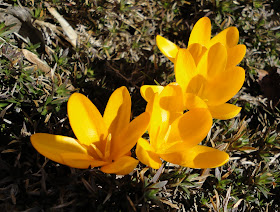Highs in the 60s can almost fool you into thinking it's springtime. My crocuses have flowered and the daffodils are popping up, but it is still about 7 weeks until the average last frost for this area (gardening zone 7). So winter gardening still prevails, even though all my indoor south-facing windows are full of seedlings, with some of the cold-tolerant crops (brussel sprouts, lettuce, parsley, onions, leeks) in front of the basement window to harden off, where it's about 50 degrees (or outside in the daytime sun).
My lunar gardening calendar declared last Sunday a good day for planting root crops, so I planted about 90 yellow onion sets, and several rows of beet seeds. I used a 3/4" diameter round wood stick to plant the onions, amending and loosening up the soil first, then poking the stick in about 3" deep, 3" apart. That made it easy to pop one onion set into each hole, root side down, then push soil over it. I also transplanted the garlic from various places in my 20' x 40' veggie garden, so those which have wintered over are all in one area of the garden. For my final "root crop" task, I filled a large pot with purchased organic soil + vermiculite + peat moss, wet it, and planted 5 of the smallest sweet potatoes which I had set aside from my harvest last year. In the past, I've tried starting them in soil as well as in mason jars of water, and the soil method has worked better for me. This is the earliest I've tried starting them, since they don't go into the garden until June, but perhaps it will give me larger plants for the garden. These little potatoes will send up leaves, with little hairy roots at the base of each stem. When I am ready to plant, I'll separate these from the starter potato and plant those "slips" to start the vines.
I've also been transplanting seedlings for other vegetables - such as tomatoes, jalapenos, sweet peppers, and pimentos - from 1" peat pellets into 3" plastic pots, with the same soil mix as described above. This will allow the roots to grow thick and healthy. As an experiment, I planted a 2 foot wide window box type planter with cilantro seedlings. I love to have fresh cilantro for making salsa when my tomatoes ripen, but the heat makes the cilantro produce flowers instead of leaves. I am hoping I can grow this planter either in cooler shade or in the basement window, to successfully harvest leaves in mid to late summer. If you have a better way to coordinate cilantro harvest with ripe tomatoes, please let me know. Just don't suggest I move back to northern New England!
My lunar gardening calendar declared last Sunday a good day for planting root crops, so I planted about 90 yellow onion sets, and several rows of beet seeds. I used a 3/4" diameter round wood stick to plant the onions, amending and loosening up the soil first, then poking the stick in about 3" deep, 3" apart. That made it easy to pop one onion set into each hole, root side down, then push soil over it. I also transplanted the garlic from various places in my 20' x 40' veggie garden, so those which have wintered over are all in one area of the garden. For my final "root crop" task, I filled a large pot with purchased organic soil + vermiculite + peat moss, wet it, and planted 5 of the smallest sweet potatoes which I had set aside from my harvest last year. In the past, I've tried starting them in soil as well as in mason jars of water, and the soil method has worked better for me. This is the earliest I've tried starting them, since they don't go into the garden until June, but perhaps it will give me larger plants for the garden. These little potatoes will send up leaves, with little hairy roots at the base of each stem. When I am ready to plant, I'll separate these from the starter potato and plant those "slips" to start the vines.
 |
| My Lenten Rose (hellebore) just began to flower. |










